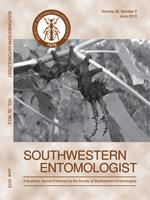White mango scale, Aulacaspis tubercularis Newstead, was sampled to better understand its biology and fluctuation in abundance in relationship to environmental variables and agronomic management in organic and conventional orchards of mango (Mangifera indica L.) in ‘El Llano’ and ‘Aticama’, Nayarit, Mexico. Sampling was done from January to June 2010 and 2011. White mango scale males group in colonies in the lower canopy of trees (P = 0.0007), while females are isolated and more homogeneously distributed (P = 0.2970) in the whole plant, with a tendency to migrate to the lower canopy when the temperature warms. Females are most abundant between 18 and 22°C and 73 and 78% relative humidity, while males reach maximum abundance at temperatures between 25 and 28°C and 66 and 71% relative humidity. As peak abundance was reached, the proportion of male colonies was more than 20 per individual female. This was more evident in 2011, a year of drought, unlike 2010 that was wet and maintained an average of 0.98 male colony per female. Management practices in organic and conventional plantations of mango influenced the abundance of the insect pest. More abundant females (3.25 per leaf) coincided with the use of humus in organically managed plantations. Tree pruning significantly decreased females from 1.8813 to 0.6456 per leaf (P = 0.0253), but an increase of 0.1750 to 0.4177 male colonies per leaf was observed, although the difference was not statistically significant (P = 0.0681).
How to translate text using browser tools
1 June 2013
Aulacaspis tubercularis Newstead in Mango Orchards of Nayarit, Mexico, and Relationship with Environmental and Agronomic Factors
P. U. Bautista-Rosales,
J. A. Ragazzo-Sánchez,
M. Calderón-Santoyo,
E. Cortéz-Mondaca,
R. Servín-Villegas
ACCESS THE FULL ARTICLE

Southwestern Entomologist
Vol. 38 • No. 2
June 2013
Vol. 38 • No. 2
June 2013




